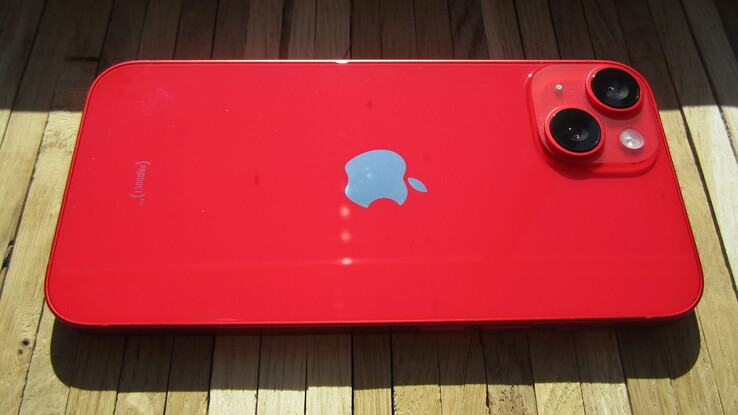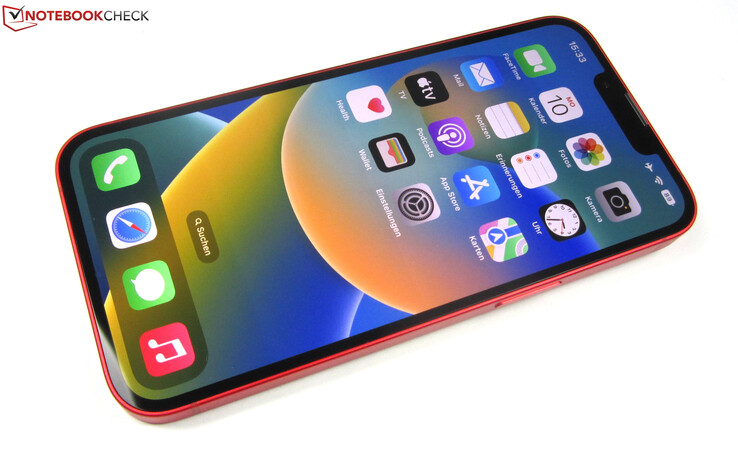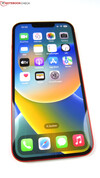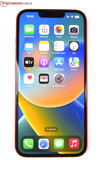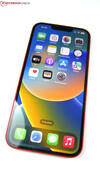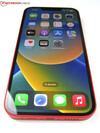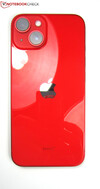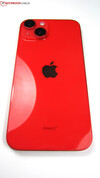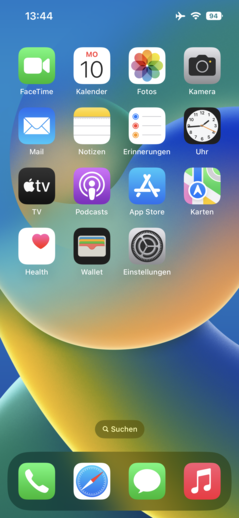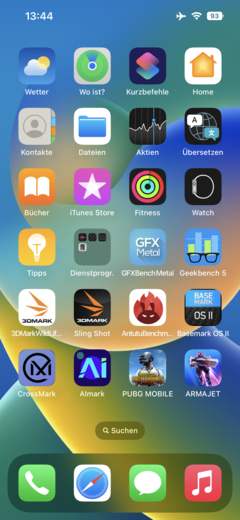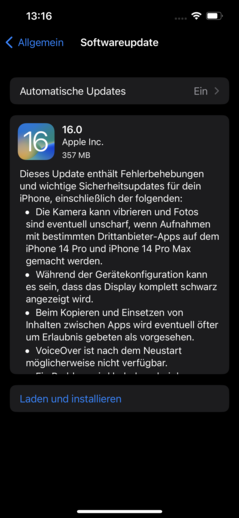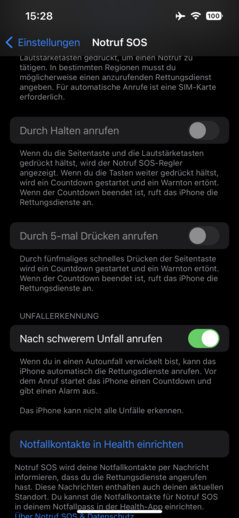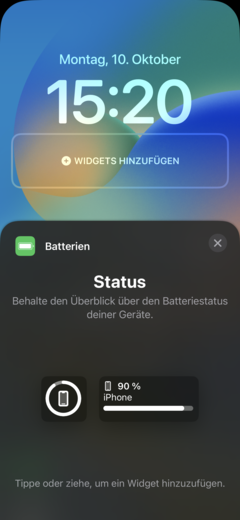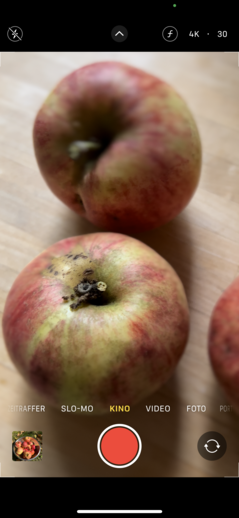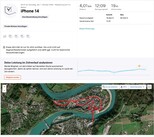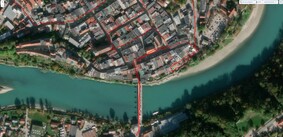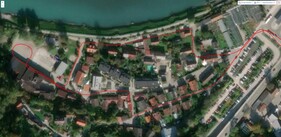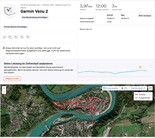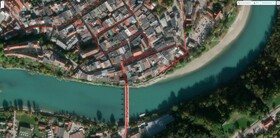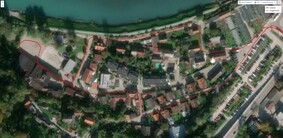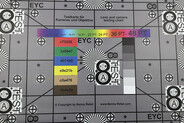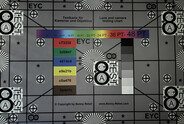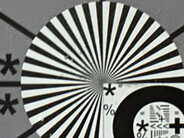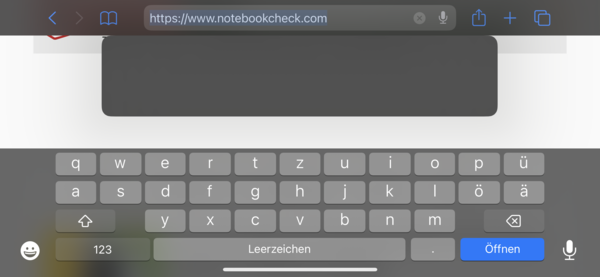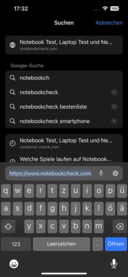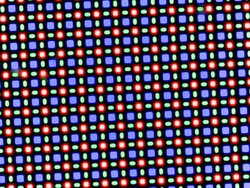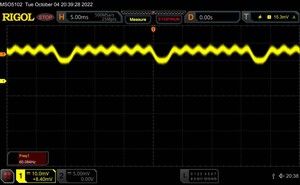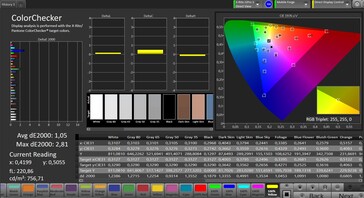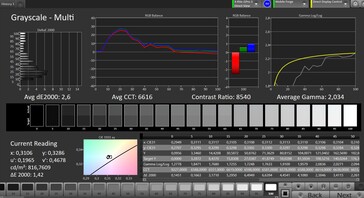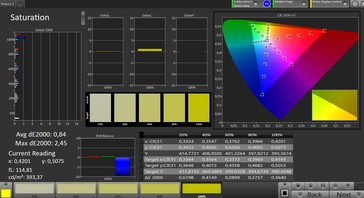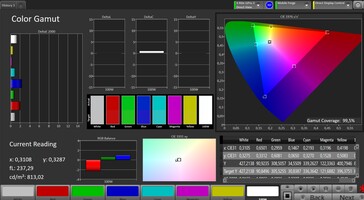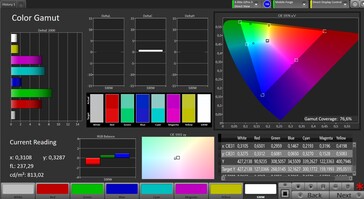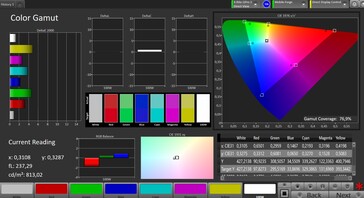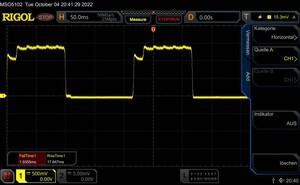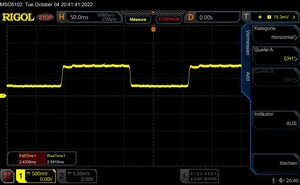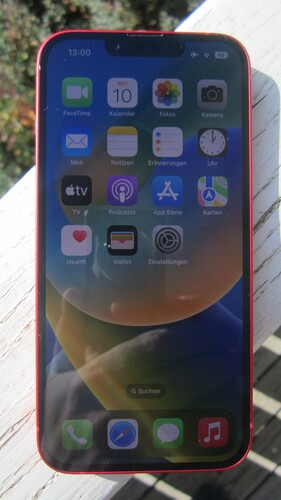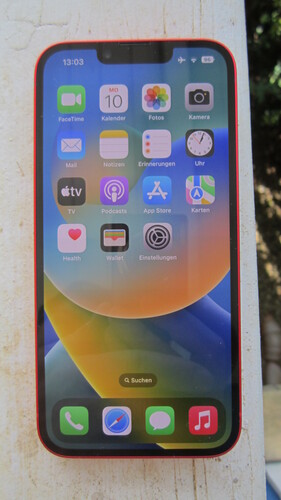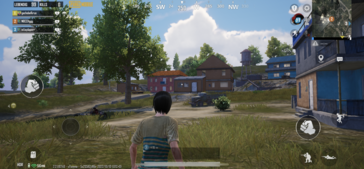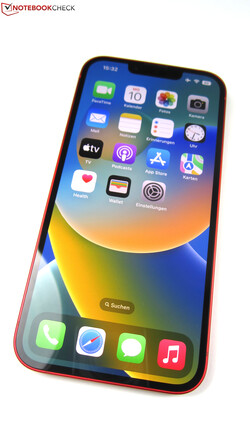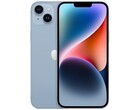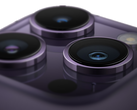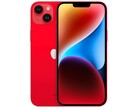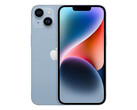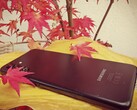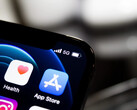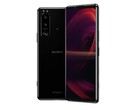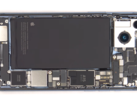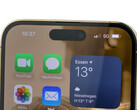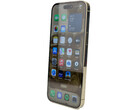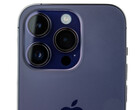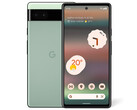Apple iPhone 14 smartphone review - Small upgrades for the Apple phone
With features such as the Dynamic Island, the always-on display, a 48-MP camera, and the latest A16 Bionic SoC, the Apple iPhone 14 Pro and the iPhone 14 Pro Max are the center of attention. The standard models do not offer the same level of new and exciting features.
The iPhone 14 is very similar to the iPhone 13. There are barely any external physical changes. However, a few things have changed on the inside. The iPhone 14 comes with the same SoC as the iPhone 13 Pro and also inherits its 12-MP main camera. Additionally, it comes with 50 % more RAM compared to its predecessor and offers exciting new features such as automatic emergency calling.
Potential Competitors in Comparison
Rating | Date | Model | Weight | Drive | Size | Resolution | Best Price |
|---|---|---|---|---|---|---|---|
| 89.2 % | 10/2022 | Apple iPhone 14 A15, A15 GPU 5-Core | 172 g | 128 GB NVMe | 6.10" | 2532x1170 | |
| 88.7 % | 10/2021 | Apple iPhone 13 A15, A15 GPU 4-Core | 173 g | 128 GB NVMe | 6.10" | 2532x1170 | |
| 88.6 % | 09/2022 | Asus Zenfone 9 SD 8+ Gen 1, Adreno 730 | 169 g | 256 GB UFS 3.1 Flash | 5.90" | 2400x1080 | |
| 87.4 % | 11/2021 | Google Pixel 6 Tensor, Mali-G78 MP20 | 207 g | 128 GB UFS 3.1 Flash | 6.40" | 2400x1080 | |
| 87 % | 08/2022 | OnePlus 10T SD 8+ Gen 1, Adreno 730 | 203.5 g | 256 GB UFS 3.1 Flash | 6.70" | 2412x1080 | |
| 87.7 % | 03/2022 | Xiaomi 12 SD 8 Gen 1, Adreno 730 | 179 g | 256 GB UFS 3.1 Flash | 6.28" | 2400x1080 |
Case - An iPhone 13 Clone with Better Repairability
If it were not for the new color variants, the iPhone 14 and the iPhone 13 would be visually indistinguishable. The flat design and the rounded-off corners are present on both models. Similarly, nothing has changed in terms of the diagonal arrangement of the rear cameras. The size and position of the display cutout, which contains the front camera and a few sensors, also have not changed.
Aside from the familiar colors black, white, and red, the iPhone 14 is now available in purple or a new, lighter blue. With 7.8 vs. 7.7 millimeters (~3.07 vs. ~3.03 inches), the Apple smartphone is very slightly thicker compared to its predecessor. Cases for the iPhone 13 will still fit the iPhone 14, however.
As per usual, Apple has not made any compromises in terms of the build quality. The aluminum case shines with great workmanship and resists twisting attempts from the corners. Apple's ceramic glass, Ceramic Shield, protects the front and back. The iPhone 14 is dust- and waterproof as specified by IP68. According to Apple, this allows the smartphone to survive being submerged up to 6 meters (~19.69 ft) under water for up to 30 minutes without any damage.
The European version of the iPhone 14 continues to offer a nano SIM slot. Meanwhile, the US models omit the SIM slot in favor of exclusive eSIM support.
The perhaps biggest change can be found inside the sleek chassis, since Apple has entirely revamped the internal layout of the smartphone. As a result, the iPhone 14 is much easier to repair than its predecessor. The smartphone can now for example be opened from the back, since the back panel is no longer attached to the case.
Connectivity - 50 Percent more RAM for the Apple Smartphone
Apple's iPhone 14 comes in three different storage configurations. The 128-GB model costs 799 USD, the 256-GB model 899 USD, and the 512-GB model 1099 USD. With 6 GB of RAM, each, the smartphone has access to 50 % more system memory compared to the 4 GB of last year's model.
Aside from NFC, MagSafe, and UWB, the connectivity also includes Bluetooth 5.3 (iPhone 13: Bluetooth 5.0). Apple's proprietary Lightning port is still used for charging and data transfers with the latter reaching speeds of up to 480 Mb/s, making them comparable to USB 2.0.
It is still unknown, whether Apple will switch to USB-C for the iPhone 15. Although the European comission has decided that USB-C will become mandatory on smartphones, the regulation only comes into effect in mid 2024, making the iPhone 16 the first of its kind that it applies to. Other rumors suggest that the iPhone 14 will not use any physical interfaces at all. Aside from wireless MagSafe charging, the switch to eSIMs on the US models also seem indicate this.
Software - iOS 16 and a Customizable Lock Screen
The iPhone 14 comes with iOS 16. At the time of testing in mid October, it has already received an update to version 16.0.3, which includes a range of bug fixes and security patches. Since Apple's latest OS version supports all smartphones from the release of the iPhone 8 and later, prospective buyers of the iPhone 14 can expect OS updates for at least 5 years. However, the manufacturer does not officially confirm this.
Although the design of iOS feels familiar, there is a plethora of new features. The customizable lock screen is likely the most prominent one and individually adaptable with user backgrounds, widgets, and live activities. Furthermore, the focus feature has been improved, sent messages can be edited retroactively, the dictation functionality has been revised to include emojis, and the iCloud photo library is now easier to share with family members. All the new features of iOS 16 are listed here.
The Dynamic Island and the always-on display are exclusive to the Pro models.
Communication and GNSS - Crash Detection
With 22 supported 5G and 28 supported 4G bands, the Apple iPhone 14 offers a very wide frequency range, which should be sufficient to get a signal almost anywhere. The Apple phone uses four antennas (4x4 MIMO) for LTE connections in order to reach a better data throughput.
The iPhone 14 comes with two new communications features, which you hopefully will not need: Crash detection and satellite SOS. The former detects high acceleration forces and is able to autonomously call emergency services after a crash. The crash detection, which is enabled by default, can be toggled from the the iPhone 14's iOS settings under Settings, Emergency SOS, Crash Detection, and Call After Severe Crash.
The satellite SOS fulfills a similar fuction as the crash detection and is only available for emergency calls while there is no active cellular or Wi-Fi connection. The satellite SOS will first be available to users in the US and Canada starting in November this year. It is unknown whether there are any plans to expand the support to include areas outside of North America.
The iPhone 14 uses Wi-Fi 6 with 2 antennas for Wi-Fi communications. It achieves consistently good transfer rates, which are slightly faster than those of the iPhone 13.
| Networking | |
| iperf3 receive AXE11000 | |
| OnePlus 10T | |
| Asus Zenfone 9 | |
| Xiaomi 12 | |
| Apple iPhone 14 | |
| Average of class Smartphone (34.8 - 1875, n=210, last 2 years) | |
| iperf3 transmit AXE11000 | |
| Asus Zenfone 9 | |
| OnePlus 10T | |
| Apple iPhone 14 | |
| Xiaomi 12 | |
| Average of class Smartphone (40.5 - 1810, n=211, last 2 years) | |
| iperf3 transmit AXE11000 6GHz | |
| Asus Zenfone 9 | |
| Average of class Smartphone (229 - 1894, n=61, last 2 years) | |
| Xiaomi 12 | |
| iperf3 receive AXE11000 6GHz | |
| Xiaomi 12 | |
| Asus Zenfone 9 | |
| Average of class Smartphone (598 - 1840, n=61, last 2 years) | |
| iperf3 transmit AX12 | |
| Apple iPhone 13 | |
| Google Pixel 6 | |
| iperf3 receive AX12 | |
| Google Pixel 6 | |
| Apple iPhone 13 | |
| Average of class Smartphone (last 2 years) | |
The iPhone 14 relies on the satellite networks GPS, GLONASS, Galileo, QZSS, and BeiDou for its locating capabilities. This allows the Apple smartphone to determine our position quickly and with an accuracy of within around 3 meters (~9.84 ft) even indoors.
On our bike ride, the geolocation of the smartphone competes against our fitness smartwatch Garmin Venu 2, which we bring along for comparison purposes. In dense housing areas, the iPhone occasionally slightly deviates from the track and in some instances the recorded route even penetrates the walls of some buildings. It still does well in terms of navigation overall and almost matches the measured total track distance of the smartwatch. For day-to-day use, the accuracy is easily sufficient.
Telephony and Call Quality - Dual eSIM or Nano SIM + eSIM
The iPhone 14 supports VoLTE and Wi-Fi calling. European models also come with a SIM slot that accepts a nano SIM card. Additionally or alternatively, an eSIM can be activated. The US models instead use a dual eSIM and no SIM slot.
The iPhone 14 offers a good call quality with clear voices even in relatively loud environments. While ambient noise may occasionally be noticeable during a call, it is then quickly cancelled out after a short time. In hands-free mode, the call quality remains distinct, although the volume of our voice decreases even when speaking into the microphone from a short distance.
Cameras - Main Camera from the iPhone 13 Pro
Like its predecessor, the iPhone 14 uses a dual camera with 12 MP, but there have been upgrades in multiple places. The 12-MP main camera is identical to that of the iPhone 13 Pro. This increases the sensor size from 1.7 to 1.9 µm and improves the aperture from f/1.6 to f/1.5.
Like the main camera, the selfie camera also benefits from a better light yield (f/1.9 vs. f/2.2). Additionally, it comes with an autofocus, which increases the sharpness slightly particularly at short distances. Compared to the iPhone 13, nothing has changed in terms of the ultra-wide camera. While it still does not feature optical image stabilization and produces good results, it cannot quite match the quality of the main camera.
The main camera of the iPhone 14 uses sensor-shift image stabilization and captures excellent pictures with natural colors and many details. There are barely any differences in the quality compared to the iPhone 13 with one exception.
Thanks to its more light-sensitive optics and the integrated image processing engine of the camera software, which Apple calls Photonic Engine, the iPhone 14 takes better night shots than the iPhone 13. Our low-light scene also shows this with the newer model capturing more details and richer colors in dark areas. Even though the Photonic Engine is a software feature, it is exclusively available on the iPhone 14 series and not enabled on older iPhones, even after they were updated to iOS 16.
The iPhone 14 also receives two new features for video recording. Many users will already be familiar with the cinema mode from the iPhone 13, which recognizes faces and automatically adds a bokeh effect and is now also available at 4K with 24 or 30 frames per second. Previously, Full HD was the limit in this mode.
The action mode is completely new and electronically stabilizes videos captured with the main or ultra-wide camera. This works very well in practice. The image is stabilized even when the camera shakes due to being attached to a bike handle or while sprinting with the iPhone in hand. Since action mode videos look quite grainy, users should not expect too much in terms of the quality.
Image Comparison
Choose a scene and navigate within the first image. One click changes the position on touchscreens. One click on the zoomed-in image opens the original in a new window. The first image shows the scaled photograph of the test device.
Tageslicht-Aufnahme 1Tageslicht-Aufnahme 2UltraweitwinkelLowlight-AufnahmeUnder fixed lighting conditions, the main camera proves itself once more. Even at a brightness of 1 lux, it captures the test chart with rich contasts and a surprisingly high color fidelity, albeit with a slightly lower sharpness than under ideal conditions.
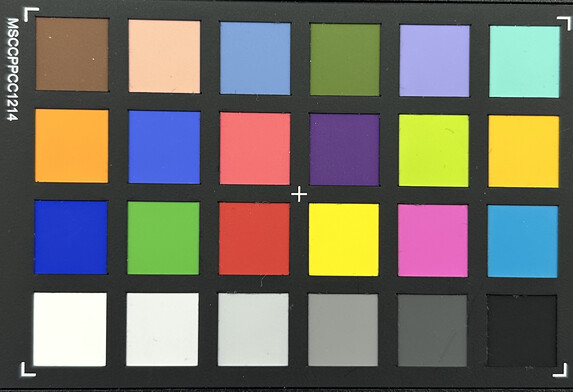
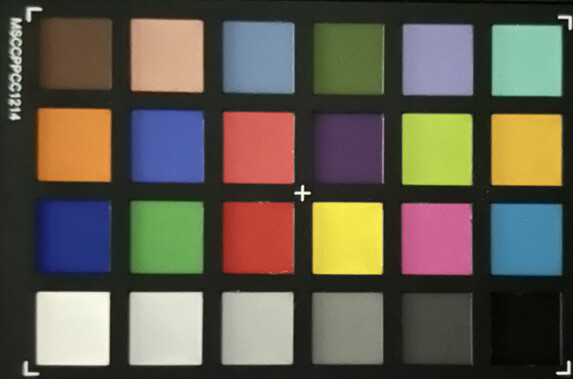
Accessories and Warranty - Still No Charger Included
The iPhone 14's scope of delivery is not exactly vast. The flat package only includes the smartphone itself, a USB cable (USB type-C to Lightning), a SIM tool, an Apple sticker, a quick-start guide, and the warranty information. Apple offers a wide range of optional accessories including an appropriate charger, MagSafe cases, and headphones.
Apple offers a standard one-year limited warranty in the US. The scope of services can be expanded with the AppleCare+ plan, which comes in the form of an unlimited monthly subscription or a one-time payment for 2 years. Regardless of the payment method, AppleCare+ includes unlimited accidental damage repairs.
Input Devices & Handling - 60 Hz as the Gold Standard
Even though the iPhone 14 costs almost 800 USD, this has done nothing to dissuade Apple from relying on a 60-Hz screen. Although animations are less smooth compared to the Pro models as a result, inputs are still very precise and responsive.
The iPhone 14 does not feature a fingerprint sensor. This makes the facial recognition Face ID the only available biometric authentication method. It is very reliable and considered to be extremely robust thanks to its use of a 3D camera. Thanks to the use of an integrated infrared sensor, Face ID even works in the dark.
Display - Same OLED Panel as the iPhone 13
Compared to the iPhone 13, the iPhone 14's display has not changed. The 6.1-inch OLED display has a resolution of 2532 x 1170 pixels for an excellent pixel density of 460 PPI. With an advertised typical maximum brightness of 800 nits, Apple is being relatively modest. The evenly illuminated OLED panel reaches an average brightness of 840.7 nits and a peak brightness of 858 nits while displaying SDR content. HDR10 and Dolby Vison are supported.
The display runs at 60 Hz at all the brightness levels we tested. This may be a problem for sensitive users, since the PWM flickering cannot be circumvented by choosing a higher brightness setting. Thus, we advise users to try the iPhone 14 before buying.
| |||||||||||||||||||||||||
Brightness Distribution: 97 %
Center on Battery: 835 cd/m²
Contrast: ∞:1 (Black: 0 cd/m²)
ΔE Color 1.05 | 0.5-29.43 Ø5
ΔE Greyscale 2.6 | 0.57-98 Ø5.3
99.5% sRGB (Calman 2D)
Gamma: 2.034
| Apple iPhone 14 OLED, 2532x1170, 6.10 | Apple iPhone 13 OLED, 2532x1170, 6.10 | Asus Zenfone 9 AMOLED , 2400x1080, 5.90 | Google Pixel 6 OLED, 2400x1080, 6.40 | OnePlus 10T Fluid AMOLED, 2412x1080, 6.70 | Xiaomi 12 OLED, 2400x1080, 6.28 | |
|---|---|---|---|---|---|---|
| Screen | 21% | -17% | -7% | -29% | -13% | |
| Brightness middle | 835 | 831 0% | 793 -5% | 805 -4% | 861 3% | 867 4% |
| Brightness | 841 | 830 -1% | 796 -5% | 805 -4% | 856 2% | 867 3% |
| Brightness Distribution | 97 | 98 1% | 97 0% | 98 1% | 97 0% | 98 1% |
| Black Level * | ||||||
| Colorchecker dE 2000 * | 1.05 | 0.77 27% | 1.9 -81% | 1.4 -33% | 2.27 -116% | 1.7 -62% |
| Colorchecker dE 2000 max. * | 2.81 | 1.52 46% | 3.4 -21% | 3.7 -32% | 4.17 -48% | 4.4 -57% |
| Greyscale dE 2000 * | 2.6 | 1.2 54% | 2.3 12% | 1.8 31% | 2.9 -12% | 1.8 31% |
| Gamma | 2.034 108% | 2.209 100% | 2.26 97% | 2.29 96% | 2.303 96% | 2.2 100% |
| CCT | 6616 98% | 6501 100% | 6860 95% | 6507 100% | 6141 106% | 6762 96% |
* ... smaller is better
Screen Flickering / PWM (Pulse-Width Modulation)
| Screen flickering / PWM detected | 60 Hz | ||
The display backlight flickers at 60 Hz (worst case, e.g., utilizing PWM) . The frequency of 60 Hz is very low, so the flickering may cause eyestrain and headaches after extended use. In comparison: 53 % of all tested devices do not use PWM to dim the display. If PWM was detected, an average of 17900 (minimum: 5 - maximum: 3846000) Hz was measured. | |||
Measurements at a fixed zoom level and different brightness settings
Using True Tone, the iPhone 14 adjusts the display colors to the ambient lighting conditions in order to ensure a consistent image. Since this causes the colors to constantly shift, we have to disable True Tone before performing our CalMAN measurements. Even without this auxiliary feature, the iPhone 14 shines with an excellent color accuracy in our test laboratory.
Display Response Times
| ↔ Response Time Black to White | ||
|---|---|---|
| 20 ms ... rise ↗ and fall ↘ combined | ↗ 2 ms rise | |
| ↘ 18 ms fall | ||
| The screen shows good response rates in our tests, but may be too slow for competitive gamers. In comparison, all tested devices range from 0.1 (minimum) to 240 (maximum) ms. » 37 % of all devices are better. This means that the measured response time is similar to the average of all tested devices (21.5 ms). | ||
| ↔ Response Time 50% Grey to 80% Grey | ||
| 5 ms ... rise ↗ and fall ↘ combined | ↗ 2 ms rise | |
| ↘ 3 ms fall | ||
| The screen shows very fast response rates in our tests and should be very well suited for fast-paced gaming. In comparison, all tested devices range from 0.2 (minimum) to 636 (maximum) ms. » 12 % of all devices are better. This means that the measured response time is better than the average of all tested devices (33.7 ms). | ||
Performance - A15 Bionic with One Additional GPU Core
New iPhone, new processor: Apple breaks with this tradition and introduces a two-class society with the iPhone 14. While the Pro models receive the brand-new A16 Bionic, the standard models have to make do with the A15 Bionic, which is the SoC from the iPhone 13 generation. There is still one small processor upgrade. The A15 Bionic in the iPhone 14 uses the same processor as the iPhone 13 Pro. As a result, it is equipped with the 5-core-GPU version instead of the 4-core-GPU version of the A15 Bionic.
Since the iPhone 13 performs essentially identically, the iPhone 14 does not appear to benefit much from the additional graphics core in synthetic benchmarks. In contrast, the additional GPU power becomes apparent in the graphics benchmarks with higher 3DMark and GFXBench scores from our test model. It also secures a small advantage in the browser benchmarks excluding Kraken 1.1, although this can likely be traced back to the newer browser version.
| CrossMark - Overall | |
| Apple iPhone 14 | |
| Asus Zenfone 9 | |
| Average Apple A15 Bionic (1132 - 1190, n=5) | |
| Xiaomi 12 | |
| Google Pixel 6 | |
| Average of class Smartphone (200 - 1474, n=165, last 2 years) | |
| OnePlus 10T | |
GFXBench (DX / GLBenchmark) 2.7: T-Rex Onscreen | 1920x1080 T-Rex Offscreen
GFXBench 3.0: on screen Manhattan Onscreen OGL | 1920x1080 1080p Manhattan Offscreen
GFXBench 3.1: on screen Manhattan ES 3.1 Onscreen | 1920x1080 Manhattan ES 3.1 Offscreen
GFXBench: on screen Car Chase Onscreen | 1920x1080 Car Chase Offscreen | on screen Aztec Ruins High Tier Onscreen | 2560x1440 Aztec Ruins High Tier Offscreen | on screen Aztec Ruins Normal Tier Onscreen | 1920x1080 Aztec Ruins Normal Tier Offscreen
| 3DMark / Wild Life Extreme Unlimited | |
| OnePlus 10T | |
| Apple iPhone 14 | |
| Asus Zenfone 9 | |
| Xiaomi 12 | |
| Apple iPhone 13 | |
| Google Pixel 6 | |
| 3DMark / Wild Life Extreme | |
| Apple iPhone 14 | |
| OnePlus 10T | |
| Asus Zenfone 9 | |
| Xiaomi 12 | |
| Apple iPhone 13 | |
| Google Pixel 6 | |
| 3DMark / Wild Life Unlimited Score | |
| Apple iPhone 14 | |
| Asus Zenfone 9 | |
| OnePlus 10T | |
| Apple iPhone 13 | |
| Xiaomi 12 | |
| Google Pixel 6 | |
| GFXBench (DX / GLBenchmark) 2.7 / T-Rex Onscreen | |
| Xiaomi 12 | |
| Asus Zenfone 9 | |
| Google Pixel 6 | |
| Apple iPhone 13 | |
| OnePlus 10T | |
| Apple iPhone 14 | |
| GFXBench (DX / GLBenchmark) 2.7 / T-Rex Offscreen | |
| Apple iPhone 14 | |
| OnePlus 10T | |
| Xiaomi 12 | |
| Apple iPhone 13 | |
| Asus Zenfone 9 | |
| Google Pixel 6 | |
| GFXBench 3.0 / Manhattan Onscreen OGL | |
| Xiaomi 12 | |
| Asus Zenfone 9 | |
| Google Pixel 6 | |
| Apple iPhone 13 | |
| OnePlus 10T | |
| Apple iPhone 14 | |
| GFXBench 3.0 / 1080p Manhattan Offscreen | |
| Apple iPhone 14 | |
| OnePlus 10T | |
| Apple iPhone 13 | |
| Xiaomi 12 | |
| Asus Zenfone 9 | |
| Google Pixel 6 | |
| GFXBench 3.1 / Manhattan ES 3.1 Onscreen | |
| Xiaomi 12 | |
| Asus Zenfone 9 | |
| Apple iPhone 13 | |
| OnePlus 10T | |
| Apple iPhone 14 | |
| Google Pixel 6 | |
| GFXBench 3.1 / Manhattan ES 3.1 Offscreen | |
| Apple iPhone 14 | |
| OnePlus 10T | |
| Xiaomi 12 | |
| Apple iPhone 13 | |
| Asus Zenfone 9 | |
| Google Pixel 6 | |
| GFXBench / Car Chase Onscreen | |
| Xiaomi 12 | |
| Asus Zenfone 9 | |
| OnePlus 10T | |
| Apple iPhone 14 | |
| Apple iPhone 13 | |
| Google Pixel 6 | |
| GFXBench / Car Chase Offscreen | |
| OnePlus 10T | |
| Apple iPhone 14 | |
| Apple iPhone 13 | |
| Asus Zenfone 9 | |
| Xiaomi 12 | |
| Google Pixel 6 | |
| GFXBench / Aztec Ruins High Tier Onscreen | |
| Asus Zenfone 9 | |
| Xiaomi 12 | |
| OnePlus 10T | |
| Apple iPhone 14 | |
| Apple iPhone 13 | |
| Google Pixel 6 | |
| GFXBench / Aztec Ruins High Tier Offscreen | |
| OnePlus 10T | |
| Asus Zenfone 9 | |
| Xiaomi 12 | |
| Apple iPhone 14 | |
| Apple iPhone 13 | |
| Google Pixel 6 | |
| GFXBench / Aztec Ruins Normal Tier Onscreen | |
| Asus Zenfone 9 | |
| Xiaomi 12 | |
| OnePlus 10T | |
| Apple iPhone 14 | |
| Google Pixel 6 | |
| GFXBench / Aztec Ruins Normal Tier Offscreen | |
| OnePlus 10T | |
| Apple iPhone 13 | |
| Asus Zenfone 9 | |
| Apple iPhone 14 | |
| Xiaomi 12 | |
| Google Pixel 6 | |
| Jetstream 2 - Total Score | |
| Apple iPhone 14 (Safari 16) | |
| Average Apple A15 Bionic (173.5 - 189.9, n=8) | |
| Apple iPhone 13 (Safari 15) | |
| Asus Zenfone 9 (Chrome 104) | |
| Xiaomi 12 (Chrome 99.0.4844.58) | |
| Average of class Smartphone (13.8 - 351, n=173, last 2 years) | |
| Google Pixel 6 (Chrome 96) | |
| OnePlus 10T (Chrome 104) | |
| Speedometer 2.0 - Result | |
| Apple iPhone 14 (Safari 16) | |
| Average Apple A15 Bionic (228 - 347, n=8) | |
| Apple iPhone 13 (Safari 15) | |
| Average of class Smartphone (14.9 - 445, n=157, last 2 years) | |
| Xiaomi 12 (Chrome 99.0.4844.58) | |
| Google Pixel 6 (Chrome 96) | |
| Asus Zenfone 9 | |
| OnePlus 10T (Chrome 104) | |
| WebXPRT 4 - Overall | |
| Average Apple A15 Bionic (188 - 189, n=3) | |
| Apple iPhone 14 (Safari 16) | |
| Asus Zenfone 9 (Chrome 104) | |
| Average of class Smartphone (22 - 202, n=160, last 2 years) | |
| OnePlus 10T | |
| WebXPRT 3 - Overall | |
| Apple iPhone 14 (Safari 16) | |
| Average Apple A15 Bionic (219 - 279, n=8) | |
| Apple iPhone 13 (Safari 15) | |
| Asus Zenfone 9 (Chrome 104) | |
| Xiaomi 12 (Chrome 99.0.4844.58) | |
| Average of class Smartphone (39 - 304, n=122, last 2 years) | |
| Google Pixel 6 (Chrome 96) | |
| OnePlus 10T (Chrome 104) | |
| Octane V2 - Total Score | |
| Apple iPhone 14 (Safari 16) | |
| Average Apple A15 Bionic (57143 - 65969, n=8) | |
| Apple iPhone 13 (Safari 15) | |
| Asus Zenfone 9 (Chrome 104) | |
| Google Pixel 6 (Chrome 96) | |
| OnePlus 10T (Chrome 104) | |
| Xiaomi 12 (Chrome 99.0.4844.58) | |
| Average of class Smartphone (4633 - 89112, n=213, last 2 years) | |
| Mozilla Kraken 1.1 - Total | |
| OnePlus 10T (Chrome 104) | |
| Average of class Smartphone (388 - 9999, n=173, last 2 years) | |
| Google Pixel 6 (Chrome 96) | |
| Xiaomi 12 (Chrome 99.0.4844.58) | |
| Asus Zenfone 9 (Chrome 104) | |
| Apple iPhone 14 (Safari 16) | |
| Average Apple A15 Bionic (414 - 507, n=8) | |
| Apple iPhone 13 (Safari 15) | |
* ... smaller is better
Gaming - Gaming at Maximum Details
With the A15 Bionic SoC and its 5-core GPU Bionic A15 5-Core, the iPhone 14's performance is sufficient to smoothly display all of the games available on the App Store. The tactical shooter PUBG Mobile, for example, is buttery smooth even at the maximum "Ultra HD/Maximum" setting. Since the performance of the A15 GPU is very high, users will most likely not run into any performance issues for years.
Since our test app Gamebench does not yet support iOS 16, we unfortunately cannot show gaming benchmarks here. We hope to be able to append our results to this article as soon as possible.
Emissions - More Than Just Lukewarm Under Load
Temperature
Under load, the iPhone 14 can reach a temperature of up to 41.7 °C (107.06 °F) and thus can feel somewhat uncomfortably warm after prolonged use. This can become especially bothersome when using the smartphone in environments that exceed the typical room temperature.
The internals of the Apple smartphone can also reach very high temperatures. As our 3DMark Wild Life stress tests show, this happens after running the benchmark app for only a few loops. Similar to the iPhone 13, the performance deficit over time amounts to about 10 to 15 %. Thanks to the high overall performance of the A15 Bionic, the throttling will likely only be an issue for very demanding apps and almost never during daily use.
(+) The maximum temperature on the upper side is 39.7 °C / 103 F, compared to the average of 35 °C / 95 F, ranging from 21.9 to 56 °C for the class Smartphone.
(±) The bottom heats up to a maximum of 41.7 °C / 107 F, compared to the average of 33.8 °C / 93 F
(+) In idle usage, the average temperature for the upper side is 22.8 °C / 73 F, compared to the device average of 32.7 °C / 91 F.
3DMark Wild Life Stress Test
| 3DMark | |
| Wild Life Stress Test Stability | |
| OnePlus 10T | |
| Apple iPhone 14 | |
| Apple iPhone 13 | |
| Google Pixel 6 | |
| Asus Zenfone 9 | |
| Xiaomi 12 | |
| Wild Life Extreme Stress Test | |
| Apple iPhone 13 | |
| Apple iPhone 14 | |
| Google Pixel 6 | |
| Asus Zenfone 9 | |
| Xiaomi 12 | |
| OnePlus 10T | |
Speakers
With one speaker on the bottom and one on the top above the notch, which serves as a hybrid speaker, the iPhone 14 uses the same stereo speaker setup that users of the iPhone 13 are already familiar with. The sound is still dominated by the treble, which makes for a somewhat feeble audio experience with annoying characteristics at high volume levels.
Wired headphones and speakers can be connected to the iPhone via the Lightning port or an appropriate adapter, while wireless devices can connect via Bluetooth 5.3. Since the aptX codecs are not supported, users should ensure their Bluetooth devices support the AAC codec.
Apple iPhone 14 audio analysis
(±) | speaker loudness is average but good (80.9 dB)
Bass 100 - 315 Hz
(-) | nearly no bass - on average 20.4% lower than median
(±) | linearity of bass is average (9.8% delta to prev. frequency)
Mids 400 - 2000 Hz
(+) | balanced mids - only 3.5% away from median
(+) | mids are linear (4.8% delta to prev. frequency)
Highs 2 - 16 kHz
(+) | balanced highs - only 3.4% away from median
(+) | highs are linear (3.9% delta to prev. frequency)
Overall 100 - 16.000 Hz
(±) | linearity of overall sound is average (16.1% difference to median)
Compared to same class
» 3% of all tested devices in this class were better, 4% similar, 93% worse
» The best had a delta of 12%, average was 38%, worst was 134%
Compared to all devices tested
» 21% of all tested devices were better, 5% similar, 74% worse
» The best had a delta of 4%, average was 25%, worst was 134%
Apple iPhone 13 audio analysis
(+) | speakers can play relatively loud (83.2 dB)
Bass 100 - 315 Hz
(-) | nearly no bass - on average 21.6% lower than median
(±) | linearity of bass is average (9.2% delta to prev. frequency)
Mids 400 - 2000 Hz
(+) | balanced mids - only 4% away from median
(+) | mids are linear (4.7% delta to prev. frequency)
Highs 2 - 16 kHz
(+) | balanced highs - only 3.6% away from median
(+) | highs are linear (6.3% delta to prev. frequency)
Overall 100 - 16.000 Hz
(±) | linearity of overall sound is average (16.6% difference to median)
Compared to same class
» 5% of all tested devices in this class were better, 4% similar, 91% worse
» The best had a delta of 12%, average was 38%, worst was 134%
Compared to all devices tested
» 24% of all tested devices were better, 5% similar, 71% worse
» The best had a delta of 4%, average was 25%, worst was 134%
Battery Life - Marginally Better Than the iPhone 13
Energy Consumption
The A15 Bionic of the iPhone 14 shines with a very good energy efficiency and consumes even less power during idle than its SoC sibling iPhone 13. The slightly higher power draw under load can likely be explained by the additional GPU core. Android competitors in our comparison cannot come close to the energy efficiency of the iPhones.
| Off / Standby | |
| Idle | |
| Load |
|
| Apple iPhone 14 3279 mAh | Apple iPhone 13 3240 mAh | Asus Zenfone 9 4300 mAh | Google Pixel 6 4614 mAh | OnePlus 10T 4800 mAh | Xiaomi 12 4500 mAh | Average Apple A15 Bionic | Average of class Smartphone | |
|---|---|---|---|---|---|---|---|---|
| Power Consumption | -5% | -14% | -8% | -8% | -42% | -24% | -38% | |
| Idle Minimum * | 0.6 | 0.6 -0% | 1.01 -68% | 0.68 -13% | 0.8 -33% | 0.87 -45% | 0.66 ? -10% | 0.897 ? -50% |
| Idle Average * | 0.8 | 1 -25% | 1.1 -38% | 1 -25% | 1.2 -50% | 1.7 -113% | 1.303 ? -63% | 1.452 ? -82% |
| Idle Maximum * | 1 | 1.3 -30% | 1.17 -17% | 1.02 -2% | 1.3 -30% | 1.82 -82% | 1.748 ? -75% | 1.629 ? -63% |
| Load Average * | 5.4 | 4.5 17% | 3.3 39% | 5.39 -0% | 3.5 35% | 4.68 13% | 4.85 ? 10% | 5.55 ? -3% |
| Load Maximum * | 9.2 | 7.8 15% | 7.89 14% | 9 2% | 5.9 36% | 7.41 19% | 7.77 ? 16% | 8.31 ? 10% |
* ... smaller is better
Power Consumption: Geekbench (150 nits)
Power Consumption: GFXBench (150 nits)
Battery Life
With 3729 mAh vs. 3240 mAh, the battery of the iPhone 14 is very slightly larger compared to the iPhone 13. While both batteries are small by Android standards, they use ther energy reserves very efficiently.
The iPhone 14 lasts ever-so-slightly longer than the iPhone 13 and with almost 17 hours of web-browsing use and 21 hours of video playback, achieves very good results.
The iPhone 14 supports a maximum charge rate of 20 watts. With the official, but unfortunately not included Apple charger, fully recharging the empty battery takes 1:34 hours. Alternatively, the smartphone can be charged at up to 15 watts via MagSafe or wirelessly via Qi Charging at up to 7.5 watts.
| Apple iPhone 14 3279 mAh | Apple iPhone 13 3240 mAh | Asus Zenfone 9 4300 mAh | Google Pixel 6 4614 mAh | OnePlus 10T 4800 mAh | Xiaomi 12 4500 mAh | |
|---|---|---|---|---|---|---|
| Battery Runtime | 1% | 4% | -17% | -1% | -7% | |
| Reader / Idle | 2689 | 2734 2% | 1685 -37% | 2020 -25% | 1795 -33% | 2558 -5% |
| H.264 | 1266 | 1224 -3% | 1401 11% | 1219 -4% | 1646 30% | 890 -30% |
| WiFi v1.3 | 1010 | 1019 1% | 825 -18% | 627 -38% | 856 -15% | 760 -25% |
| Load | 289 | 299 3% | 462 60% | 291 1% | 332 15% | 385 33% |
Pros
Cons
Verdict on the Apple iPhone 14
Compared to last year's iPhone 13, not much has changed for the latest iPhone. An improved main camera, a stronger GPU part for the A15 Bionic, a slightly bigger battery, and software features such as a crash detection - those are some of the most important, but also almost the entirety of the new features the iPhone 14 has to offer.
Apple's message is clear: Users who are looking for innovation along the lines of the 48-MP camera, a faster SoC, or a 120-Hz display, will have to go with the more expensive pro models.
Spotting the differences between the iPhone 14 and its predecessor almost requires a magnifying glass. Regardless, the Apple phone remains an excellent, albeit expensive smartphone overall.
Despite or due to the mini upgrade, our verdict remains identical to that on the predecessor. The iPhone 14, too, is an excellent smartphone that belongs to the most high-end device class thanks to its build quality, display, camera, battery life, and performance.
Of course, there are a few drawbacks to the iPhone 14. Charging 800 USD for a smartphone with a 60-Hz display is something only Apple can get away with. Similarly, users are still going to have to contend with relatively slow fast charging and a wide notch. Furthermore, Apple's much-lauded satellite emergency SOS is limited to the US and Canada for now.
Alternatives to the iPhone 14 include both the iPhone 13 and the iPhone 13 Pro with the latter offering advantages such as an adaptive 120-Hz display and an additional telephoto camera for almost the same price. On the Android side, we recommend compact and powerful models such as the Asus ZenFone 9 or the Xiaomi 12.
Price and Availability
When purchased on the official store directly from Apple, the base model iPhone 14 with 128 GB storage costs 799 USD. The 256-GB and 512-GB models cost 899 USD and 1099 USD, respectively. Other retailers often list the smartphone for a similar price.
Apple iPhone 14
-
10/13/2022 v7
Manuel Masiero


 Deutsch
Deutsch English
English Español
Español Français
Français Italiano
Italiano Nederlands
Nederlands Polski
Polski Português
Português Русский
Русский Türkçe
Türkçe Svenska
Svenska Chinese
Chinese Magyar
Magyar